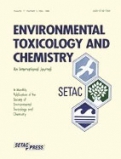Combined exposure to cyanobacteria and carbaryl results in antagonistic effects on the reproduction of Daphnia pulex
Combined exposure to cyanobacteria and carbaryl results in antagonistic effects on the reproduction of Daphnia pulex  In aquatic ecosystems, Daphnia are exposed to a wide variety of natural and chemical stressors that can cause interactive effects resulting in an increased impact on aquatic ecosystems. The authors therefore investigated the interactive effects of harmful cyanobacteria (cyanoHABs) with carbaryl in Daphnia pulex, because cyanobacteria have become an important concern for aquatic ecosystems. Daphnia were exposed for 21 d to 4 selected cyanobacteria (Aphanizomenon sp., Cylindrospermopsis raciborskii, Microcystis aeruginosa, and Oscillatoria sp), carbaryl, and all binary combinations of carbaryl and each individual cyanobacterium. Results were analyzed with both the independent action and the concentration addition model.
In aquatic ecosystems, Daphnia are exposed to a wide variety of natural and chemical stressors that can cause interactive effects resulting in an increased impact on aquatic ecosystems. The authors therefore investigated the interactive effects of harmful cyanobacteria (cyanoHABs) with carbaryl in Daphnia pulex, because cyanobacteria have become an important concern for aquatic ecosystems. Daphnia were exposed for 21 d to 4 selected cyanobacteria (Aphanizomenon sp., Cylindrospermopsis raciborskii, Microcystis aeruginosa, and Oscillatoria sp), carbaryl, and all binary combinations of carbaryl and each individual cyanobacterium. Results were analyzed with both the independent action and the concentration addition model.
NEW PUBLICATION
Combined exposure to cyanobacteria and carbaryl results in antagonistic effects on the reproduction of Daphnia pulex  In aquatic ecosystems, Daphnia are exposed to a wide variety of natural and chemical stressors that can cause interactive effects resulting in an increased impact on aquatic ecosystems. The authors therefore investigated the interactive effects of harmful cyanobacteria (cyanoHABs) with carbaryl in Daphnia pulex, because cyanobacteria have become an important concern for aquatic ecosystems. Daphnia were exposed for 21 d to 4 selected cyanobacteria (Aphanizomenon sp., Cylindrospermopsis raciborskii, Microcystis aeruginosa, and Oscillatoria sp), carbaryl, and all binary combinations of carbaryl and each individual cyanobacterium. Results were analyzed with both the independent action and the concentration addition model.
In aquatic ecosystems, Daphnia are exposed to a wide variety of natural and chemical stressors that can cause interactive effects resulting in an increased impact on aquatic ecosystems. The authors therefore investigated the interactive effects of harmful cyanobacteria (cyanoHABs) with carbaryl in Daphnia pulex, because cyanobacteria have become an important concern for aquatic ecosystems. Daphnia were exposed for 21 d to 4 selected cyanobacteria (Aphanizomenon sp., Cylindrospermopsis raciborskii, Microcystis aeruginosa, and Oscillatoria sp), carbaryl, and all binary combinations of carbaryl and each individual cyanobacterium. Results were analyzed with both the independent action and the concentration addition model.
The estimated median effect concentration (EC50) for carbaryl was comparable between the experiments, ranging from 2.28 µg/L to 5.94 µg/L. The EC50 for cyanobacteria ranged from 13.45% of the total diet ratio for Microcystis to 66.69% of the diet ratio for Oscillatoria. In combination with carbaryl, the response of Daphnia to 3 of the 4 cyanobacteria demonstrated antagonistic deviation patterns (p < 0.05). Exposure to combinations of carbaryl and Cylindrospermopsis did not result in statistically significant deviations from both reference models. The results may have important implications for pesticide risk assessment, underlining the impact of interactive effects on aquatic organisms. Based on these results, the authors suggest that both the independent action and the concentration addition model can serve as a protective approach in risk assessment of carbaryl in the presence of cyanobacterial blooms.
Full reference (link)
Jana Asselman, Joris Meys, Wilem Waegeman, Bernard De Baets, Karel AC De Schamphelaere. 2013. Combined exposure to cyanobacteria and carbaryl results in antagonistic effects on the reproduction of Daphnia pulex. Environmental Toxicology & Chemistry 32:2153-2158.
